Configure Static Route – GNS3 Lab
In this tutorial we will connect two routers via static route with GNS3.
Static route and Dynamic route
Static route tells the device exactly where to send traffic, no matter what. Static route is often used when your network has only a few routers or there is only one route from a source to a destination. Dynamic routes, on the other hand, use a routing protocol to determine the best path and the routes can be changed depending on specific parameters (like bandwidth, delay, cost…). With dynamic routes, routers can communicate with each other to exchange routing information. In ROUTE 642-902 you will learn about dynamic routing protocols such as OSPF, EIGRP and BGP (RIP is also a dynamic routing protocol but it is not mentioned in ROUTE).
The simple syntax of static route:
ip route destination-network-address subnet-mask {next-hop-IP-address | exit-interface}
+ destination-network-address: destination network address of the remote network
+ subnet mask: subnet mask of the destination network
+ next-hop-IP-address: the IP address of the receiving interface on the next-hop router
+ exit-interface: the local interface of this router where the packets will go out
Now we consider a real-world example of static routing. Suppose that your company has 2 branches located in New York and Chicago. As the administrator of the network, you are tasked to connect them so that employees in the two LANs can communicate with each other. After careful consideration you decided to connect them via static route.

In GNS3, place 2 routers and connect them as the image below, I used IOS c2600-bin-mz.123-6f.bin to save some RAM (only require 64MB/router). We will use two loopback interfaces to simulate two Ethernet LANs.
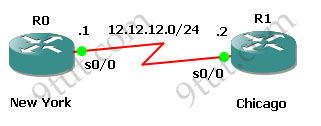
Configuring interfaces on R0
R0(config)#interface s0/0
R0(config-if)#ip address 12.12.12.1 255.255.255.0
R0(config-if)#no shutdown
R0(config-if)#interface lo0
R0(config-if)#ip address 10.0.0.1 255.0.0.0
R0(config-if)#exit
Configuring interfaces on R1
R0(config)#interface s0/0
R0(config-if)#ip address 12.12.12.2 255.255.255.0
R0(config-if)#no shutdown
R0(config-if)#interface lo0
R0(config-if)#ip address 172.16.0.1 255.255.0.0
R0(config-if)#exit
Now if we check the routing table of R0 & R1 by the command show ip route on both R0 and R1
On R0:
R0# show ip route
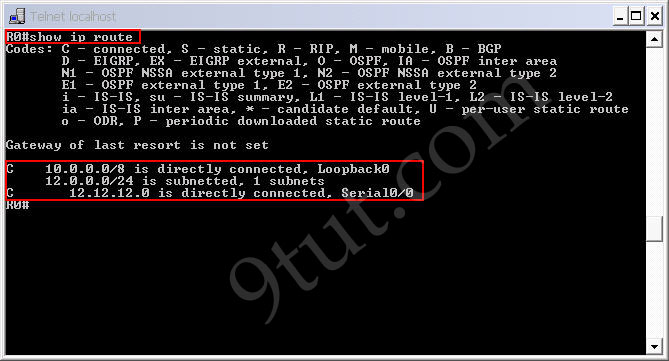
The letter “C” means “connected” or “directly connected”. So there are 2 networks that are directly connected to R0: 10.0.0.0/8 and 12.12.12.0
On R1
R1# show ip route
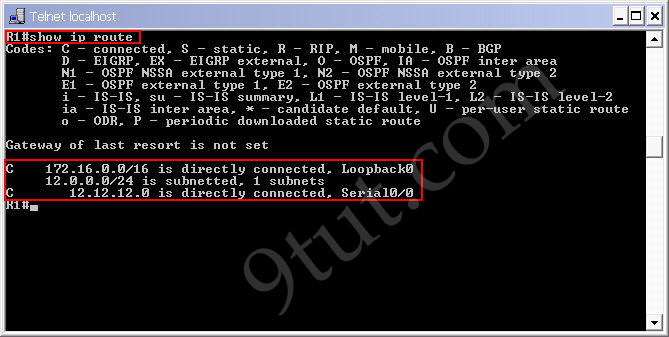
Configuring static route on R0
R0(config)#ip route 172.16.0.0 255.255.0.0 12.12.12.2
Configuring static route on R1
R1(config)#ip route 10.0.0.0 255.0.0.0 12.12.12.1
Notice that static route works one-way. It means we have to add static route to both R0 and R1 so that R0 and R1 can communicate.

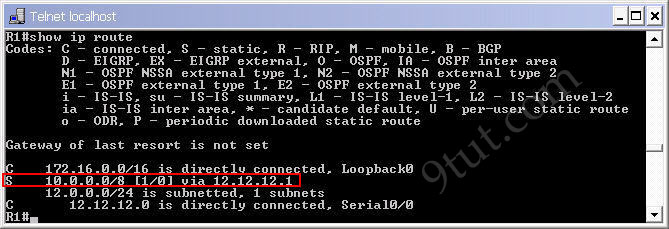
Now try to ping each far end network
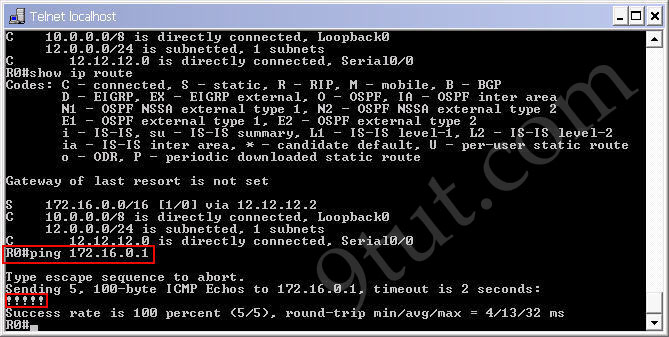
(Note: In fact, R0 can successfully ping R1 right after adding the static route to R0)
Administrative distance of a static route.
After adding two static routes in R0 & R1 routers, the routing tables of two routers contain these lines:
S 10.0.0.0/8 [1/0] via 12.12.12.1 (on R1)
S 172.16.0.0/16 [1/0] via 12.12.12.2 (on R0)
The “S” letter tells us this is a static route. The networks 10.0.0.0/8 and 172.16.0.0/16 are the destinations of this static route and if the routers want to reach them they must send packets to 12.12.12.1 (on R1) and 12.12.12.2 (on R2). These parameters are straightforward and easy to understand. But what is [1/0]? Well, 1 is the administrative distance (AD) and 0 is the metric of that static route.
The administrative distance is a measure of trustworthiness where lower numbers are considered to be more trustworthy than higher numbers. The route with the lowest administrative distance value is the preferred route that the router selects. Administrative distance is the value from 0 to 255.
Directly connected routes have an administrative distance of 0. Static routes have an administrative distance
of 1 so in the outputs above you will see the administrative distance of both static routes are 1.
The router treats a static route pointing to an interface the same as a connected interface so the its AD is 0. If you configure a static route pointing to an exiting interface (for example: “ip route 172.16.0.0 255.255.0.0 s0/0” on R0) then the AD will not be shown.
(For your information, EIGRP has an administrative distance of 90. IGRP has an administrative distance of 100. OSPF has an administrative distance of 110. And RIP has an administrative distance of 120)



can apply this lab in packet tracer……please :)
In fact, there is no difference when applying this lab in packet tracer.
Good Article it helped me!!
@rasha: maybe u forgot to set the clock rate to the DCE side..
ya easy to get the resulssssssssssss!!!!!!!!!
Can I have Latest CCNA Dumps.
My Mail-id is – bv.veeru@hotmail.com
very helpful for me.
Can you please add complete voice based training ?
i comleted CCNA just 15 days ego anybody helps me for pass the exam?
please can i have latest CCNA DUMP?
cant GNS3 work on window 7 and vista? pls if it can, can you let me know how to go about it. i will be grateful if i can get latest dumps. Thank
dumps for CCNA plssssssss
my email is sunexy049@yahoo.com Thanks. will be expecting
This site has been very helpful to me. I have six weeks to write my CCNA and any suggestions and current dump will be helpful. email: nanaluv32@yahoo.com. Thank you very much.
can i have latest ccnp (Routing dumps
)
Please respond if anyone has the latest dumps as of April lastweek
some one send me latest ccna and ccna security dump please….
sfurtila@yahoo.com
Hi, every one.I am savun I need to do CCNA exam, but not sure to pass.
so please comment to me. How I can to do for CCNA certificate. thanks for all………..
Why we implemented LOOPBACK here ???we were trying only static routing ?? Is it necessary to do loopback when we do static routing ???
@Sidheek Mohammed: We don’t need to use loopback when doing static routing. The two loopback interfaces here are just used to illustrate 2 far-away networks. If we don’t use these 2 loopback interfaces we have to add 2 more routers to test the static route commands.
Hi,
Perhaps a really silly question, I have this set up in GSN3 – Im hooking up 2 vmware devices (ubuntu boxes), I can ping router one and router two using the external ips.
router a cisco 7200
interface fe 0/0 10.0.0.2
interface fe 1/0 192.168.3.1
router b cisco 7200
interface fe 0/0 10.0.0.1
interface fe 1/0 192.168.2.1
I did the static routing of this:
Router A(config)#ip route 192.168.2.0 255.255.255.0 10.0.0.1
Router B(config)#ip route 192.168.3.0 255.255.255.0 10.0.0.2
I can ping A from B using:
router a#ping 192.168.2.1
and
router b#ping 192.168.3.1
I can also ping the VMARE boxes
from their respective routers (and I can ping the respective routers from computers)
(comp_a router_a router_b comp_b)
but comp_a cannot ping comp_b and vica versa.
Any ideas?
Hi heath,
static routes are only “point to point” routes. you cant ping from a host on router a to a host on router b. to get this working you have to enable any routing protocol f.e. ripv2.
greets
I am trying GNS3 now after using PT extensively. Does the loopback address kind of “simulate” a host on the LAN behind those routers? For PT, we can add a PC on both ends of those routers and then try to ping each other. For GNS3, the alternative would be a loopback address or another router?
@jeff
you could try adding a vmware machine as test computer
you could add several vmware machines as test computers!
you could add as many vmware machines as you like :)
Hey xallax, you should create a video tutorial or something about gns3 along with your package (if it doesn’t have one yet).
@jeff
well, here’s something interesting:
http://sourceforge.net/projects/gns-3/files/GNS3/0.5/GNS3-0.5-tutorial.pdf/download
add default gateway (router ip to which pc connected) in your pc .
@Health:- add default gateway (router ip to which pc connected) in your pc .
hi!!!!!! 9tut
which type tutorials will come in CCNA exam?
&
Plz send me latest dums plz
rajenpatel30189@gmail.com
Can anyone send ccnp materials to my id devendrangr at yahoo.in inorder to take the exam.
@Rahul nice observation
@Health, really you didn’t specify what ip configuration you put to your host A and B
dear all i am need ccna latest dumps if any one have then please send me on my email id
jamilshah_2005@yahoo.com
thanks
regards
Jamil shah Afridi
I do it with both GNS 3 and packet trace but it does not work good I dont know what is the problem?
Check out GNS3 workbench…it has training and a fully loaded ubuntu 10.10 vmware image preloaded w/ ccna labs, GNS3 and documentation.
http://rednectar.net/gns3-workbench/
This is what I use plus when you add this to 9tut, you are set. Peace
thanks 9tut
THANKS 9TUT
Good Examples with Picture :) Thanku
Hi All I have got my ccna icnd1 exam coming up on thr 25th of may, can you please send the latest brain dump to me my email is
friendlywind@gmail.com
Thank you in advance.
j’ai deux routeurs et deux virtuel box guest et j’arrive pas a les router avec un routage statique pouvez vous m’aidé et merci d’avance ^^
voila mon e-mail hassanefes@hotmail.com
This site is helpful indeed,i’ve been out f class 4 a while due 2 work commitments bt nw i cn catch up coz f dis mouth watering tutoria. Thanx CCNA family
hiiiii,
this is tumendra bisen. i am preparing the ccna certification exam. if you have latest dumps and sumulator so plz send me on my email
tumendra24bisen@gmail.com.so that i can prepare 100%.
this is very good topic it he;lp me alot for understanding static routing thanx alot
its very good and informative website
Someone please sent me the lastest ccna dump. My email aznkoolguy69@hotmail.com
Hi,
Why R0#ping 172.16.0.2 not succeed ?
what is the commands for configuring the ipv6 in gns3
also how to assign the ipv6 address in sysyem and process ping
my email is ilkin.zeynalovich@gmail.com . please send me dump for excamen CCNA